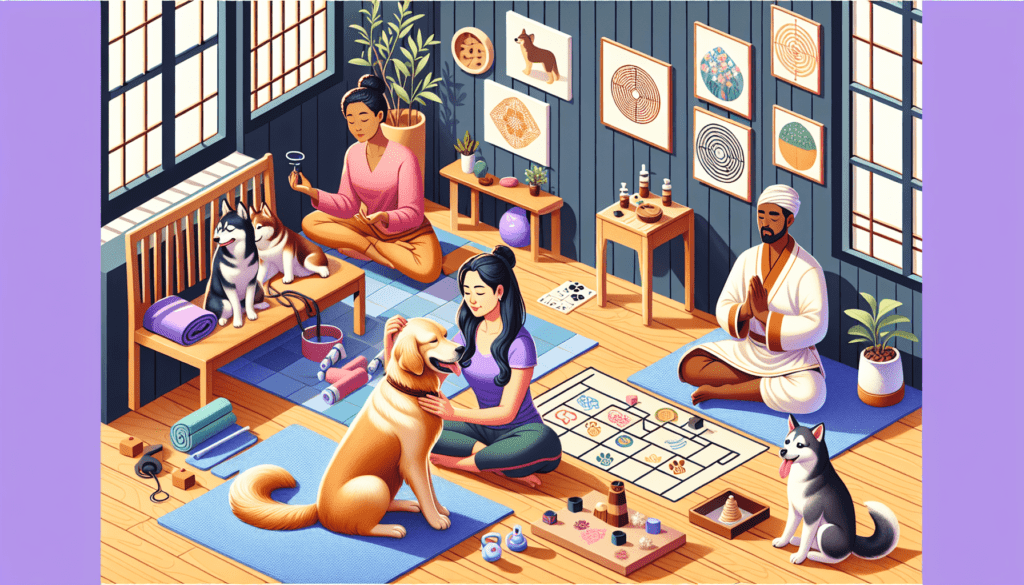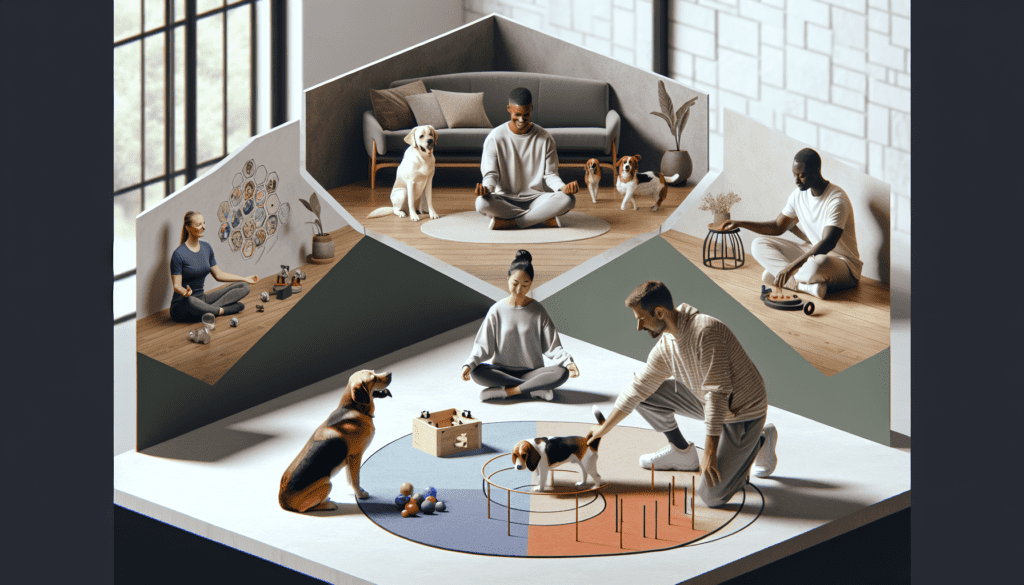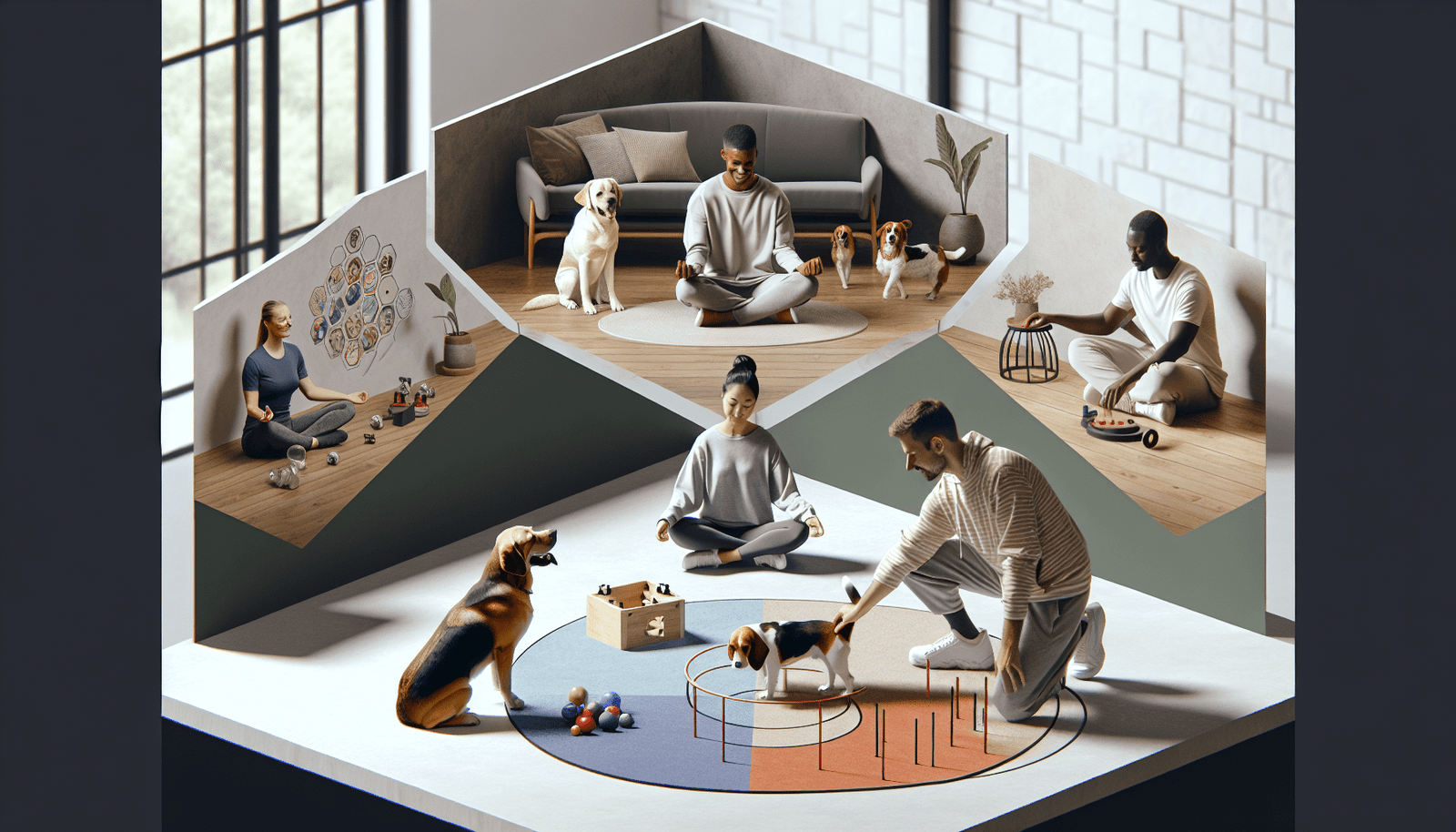Ready to unwind and relax with your furry best friend? If you’re looking for some gentle and calming exercises or activities to enjoy with your dog, we’ve got you covered. Whether you want to create a serene atmosphere or simply enjoy some quality bonding time, there are several options to explore. From a peaceful walk in nature to soothing massages, these activities are sure to bring tranquility to both you and your beloved canine companion.
Mindful walks
Going for mindful walks with your dog can be a wonderful way to relax and connect with nature. The first step is to find a quiet and peaceful place where both you and your furry friend can unwind. Look for a park, a trail, or any other outdoor area that is free from distractions and noise. Once you’ve found the perfect spot, it’s time to start your mindful walk.
Walking at a relaxed and slow pace is key to creating a calming environment for both you and your dog. Instead of rushing through the walk, focus on taking slow and intentional steps. This will not only help you stay present, but it will also allow your dog to thoroughly explore their surroundings. Let your dog take the lead and encourage them to sniff and investigate different scents along the way. This simple act can be incredibly enriching for their senses and help them feel more relaxed and engaged.
As you walk, practice deep breathing to further enhance the calming effects of the exercise. Take slow and deep breaths in through your nose, and exhale slowly through your mouth. This will not only help you relax, but it will also send a calming signal to your dog. By staying present and focusing on your breath, you can create a peaceful atmosphere that benefits both you and your furry companion.
Massage
Just like humans, dogs can greatly benefit from the therapeutic effects of a good massage. Creating a calm and cozy environment is essential for a successful massage session. Find a quiet and comfortable space where both you and your dog can relax. Dim the lights, play some soft background music if desired, and make sure the room is at a comfortable temperature.
To start the massage, begin with gentle strokes on your dog’s body. Use your palms and fingertips to apply light pressure and move in slow and deliberate motions. Start from the neck area and work your way down to the tail, paying attention to areas that your dog enjoys being touched. Each dog is unique, so observe their body language and reactions to determine which areas they find most soothing.
As you massage your dog, use soothing and rhythmic motions to help them unwind. Circular motions with a gentle pressure can be especially soothing for dogs. Take your time and be mindful of your dog’s responses. If they show signs of discomfort or tension, adjust your technique accordingly. The goal is to provide a relaxing experience for your dog, so modify your approach to suit their individual needs.

Meditation
Believe it or not, dogs can also benefit from meditation sessions with their owners. Finding a quiet and comfortable space is essential to create a peaceful atmosphere for meditation. Choose a spot where you and your dog can sit together without distractions. This can be a cozy corner of your home or even a serene outdoor location.
Once you’ve found your meditation spot, sit in a relaxed position with your dog beside you. You can sit cross-legged or in any other comfortable position that allows you to maintain good posture. Close your eyes, take a deep breath in, and invite your dog to relax by your side.
During the meditation session, focus on your breath and allow any thoughts or worries to simply flow away. Invite your dog to do the same by maintaining a calm and peaceful energy. Starting with short meditation sessions and gradually increasing the duration can help both you and your dog ease into the practice.
If you find it challenging to meditate without guidance, there are guided meditations specifically designed for dogs available online. These meditations often incorporate sounds and calming tones that can help your dog relax further. Experiment with different guided meditations to find the ones that resonate with your dog the most.
Puzzle toys
Puzzle toys are a great way to engage your dog’s problem-solving skills while providing mental stimulation and relaxation. When choosing puzzle toys, make sure to consider your dog’s size and skill level. You want the toys to pose a challenge without being too overwhelming or frustrating for your furry friend.
To make puzzle toys even more enticing, fill them with treats or food that your dog enjoys. This will add an extra incentive for them to work through the puzzles. Introduce the toy to your dog and demonstrate how to solve it. You can show them how to manipulate the different parts to access the treats inside.
Encourage your dog to use their problem-solving skills and observe them as they figure out the puzzles. It’s important to supervise them during this activity to ensure their safety and to prevent any potential frustration. Puzzle toys can be a fun and calming activity for dogs, providing them with mental stimulation and a sense of accomplishment.

Relaxation music
Calming music can have a soothing effect on both humans and dogs. There are plenty of specially designed relaxation music options available that are specifically created for dogs. Look for music that has calming melodies and gentle instrumentals, as well as nature sounds like bird chirping or flowing water.
Create a relaxing atmosphere by playing the music in a quiet and comfortable space. Dim the lights or light some candles to further enhance the peaceful ambiance. Sit or lie down with your dog and allow them to unwind and absorb the calming sounds. Pay attention to your dog’s reaction and adjust the music as needed. Some dogs may respond better to classical music, while others may prefer nature sounds.
Relaxation music can be a valuable tool to help your dog relax during stressful times, such as during thunderstorms or when they are feeling anxious. Incorporating regular relaxation music sessions into your routine can also serve as a cue for your dog to unwind and find comfort.
Yoga for dogs
Yoga is not just for humans; it can also benefit dogs by promoting relaxation, flexibility, and body awareness. To practice yoga with your dog, find a quiet and spacious area where you can both move freely. This can be in your living room, backyard, or any other location where you have enough space to stretch and explore different poses.
Before starting your canine yoga session, it’s important to research and learn some dog-specific yoga poses. While some poses will be similar to those practiced by humans, others are specifically adapted for dogs. Start with simple poses that focus on gentle stretching and relaxation.
To encourage your dog’s participation, use treats or praise as positive reinforcement. Treats can be given after each successful attempt at a pose, helping your dog associate yoga with positive experiences. Take your time and be patient as you guide your dog through each pose, allowing them to explore their flexibility and body movement.
Keep in mind that not all dogs will enjoy yoga, so always respect your dog’s boundaries. If they show signs of discomfort or resistance, it’s best to stop and try again another time. Always prioritize your dog’s comfort and well-being during yoga sessions.
Aromatherapy
Aromatherapy can be a wonderful tool to help calm and relax dogs. However, it’s important to note that not all essential oils are safe for dogs. Before using any essential oils, do your research and ensure they are safe for canine use. Some safe options include lavender, chamomile, and frankincense.
Choose calming scents that are known for their relaxation properties. Lavender, in particular, is often used to promote a sense of calm in both humans and dogs. You can diffuse the essential oils in a well-ventilated area, so there is no direct contact with your dog’s skin.
Observe your dog’s response to the scents and adjust accordingly. Some dogs may show signs of relaxation and contentment when exposed to certain scents, while others may become agitated or anxious. Avoid overwhelming your dog with strong fragrances and always prioritize their well-being and comfort.
T-touch technique
The T-touch technique is a gentle and effective way to calm and relax dogs. It involves using circular motions with light pressure to massage your dog’s body. The technique focuses on areas with tension or sensitivity, helping to release any blocked energy and promote relaxation.
Before practicing the T-touch technique, it’s important to learn the basics. There are many resources available online that provide step-by-step instructions and demonstrations. Take your time to familiarize yourself with the technique before applying it to your dog.
Start by using gentle circular motions with your fingertips or the pads of your fingers. Apply light pressure and move slowly across your dog’s body. Pay attention to your dog’s responses and adjust the pressure and speed of your motions accordingly. If you notice any areas of tension or sensitivity, spend extra time in those areas to help release the tension.
The T-touch technique can be practiced regularly for optimal results. It’s a soothing and nurturing activity that can strengthen the bond between you and your dog while providing them with a sense of relaxation and comfort.
Weighted blankets
Weighted blankets can be a useful tool to help dogs feel secure and calm. They work by providing gentle pressure to the body, similar to the sensation of being hugged. Weighted blankets can be especially beneficial for dogs that experience anxiety or have difficulty settling down.
When choosing a weighted blanket for your dog, make sure to select one that is suitable for their size and weight. Introduce the blanket slowly and allow your dog to get comfortable with it. Some dogs may need time to adjust to the weight, so be patient and allow them to take their time.
During relaxation time, place the weighted blanket over your dog’s body. Ensure that the blanket is not too heavy or restrictive, as you want your dog to be able to move and reposition themselves comfortably. The goal is to provide a gentle and soothing pressure without causing any discomfort.
Always monitor your dog’s comfort level when using a weighted blanket. If you notice any signs of distress or discomfort, remove the blanket and try again at a later time. Weighted blankets can be a valuable tool in helping your dog feel safe and calm, but it’s important to use them responsibly and ensure your dog’s well-being.
Tug-of-war
Engaging in a controlled and supervised game of tug-of-war can be a fun and interactive way to provide mental and physical exercise for your dog. Tug-of-war taps into your dog’s natural instincts and provides an outlet for their energy.
To play tug-of-war safely, make sure to find a durable and safe tug toy. Look for toys specifically designed for tug-of-war that can withstand your dog’s pulling and tugging. Avoid using items such as socks or towels, as they can easily tear and may not be safe for your dog to play with.
As you engage in the game, it’s important to set rules and boundaries. Teach your dog to release the toy on command, such as “drop it” or “let go.” This helps ensure that the game remains safe and controlled. Use the game as an opportunity to reinforce obedience and provide mental stimulation for your dog.
It’s important to note that tug-of-war should never turn into a rough or aggressive game. It should always be played in a controlled and respectful manner. If you notice any signs of aggression or teeth-clenching on your dog’s part, it’s best to stop the game and seek professional guidance.
In conclusion, there are numerous calming exercises and activities that you can enjoy with your dog. From mindful walks and massages to meditation and puzzle toys, these activities provide mental and physical stimulation while promoting relaxation and a stronger bond between you and your furry friend. Take the time to explore different options and find the ones that resonate the most with your dog. Remember to always prioritize your dog’s comfort and well-being, and enjoy the moments of calm and connection that these activities can bring.

